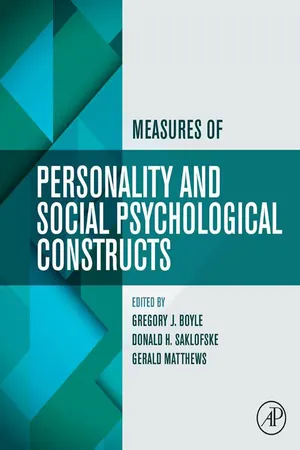In this chapter, we review several measures of hope and optimism–two distinct but related types of expectations for the future. We begin by reviewing dominant theoretical perspectives on these two constructs and explicating the meaning of each term, including the conceptual uniqueness and overlap of hope and optimism. We also review commonly used measures of hope (i.e., Adult Hope Scale, Herth Hope Scale and Index, Beck Hopelessness Scale, Hunter Opinions and Personal Expectations Scale, Integrative Hope Scale, Snyder State Hope Scale, Work Hope Scale) and optimism (Life Orientation Test, Generalized Expectancy for Success Scale, Personal and Social Optimism Questionnaire, Positive and Negative Expectancies Questionnaires, Cancer Patient Optimism Scale, HIV Treatment Optimism Scale). For heuristic purposes, we present the measures of hope and optimism separately and then further divide these measures into global measures and more context-specific measures. In each case, we review evidence supporting the reliability and construct validity of the relevant measurement instruments and make recommendations for appropriate use.
Keywords
hope; optimism; positive psychology; expectations; perceptions of the future
Individual differences in expectations of the future are a basic ingredient of many theoretical frameworks in psychology, including models of depression (Beck, 1967), subjective well-being (Bryant & Veroff, 1984), and generalized outcome expectancies (Rotter, 1954). In this chapter, we consider two distinct, yet highly related types of future perceptions, which together form part of the conceptual bedrock of modern positive psychology: namely, hope and optimism. We begin by reviewing dominant theoretical perspectives on hope and optimism and explicate the meaning of each term, including the conceptual uniqueness and overlap of hope and optimism. We then examine and evaluate the most popular ways of measuring hope and optimism in the empirical literature, including global versus domain-specific instruments.
Previous theorists and researchers have often blurred conceptual distinctions between hope and optimism. Although separate lines of work have evolved for each construct, the two terms have frequently been used interchangeably in the literature, with optimists sometimes said to be ‘hopeful’ toward the future (e.g., Affleck & Tennen, 1996) and pessimists said to exhibit ‘hopelessness’ (e.g., Beck et al., 1974). Although hope and optimism share a great deal of conceptual ground in common, they each also possess unique features that distinguish them from each other. Theorists and researchers must be careful to explicate and define each of these constructs clearly and precisely.
Concerning conceptual commonalities, both hope and optimism assume that whereas contextual information is important, stable trait-like beliefs also influence people’s cognitions and behaviors in pursuit of goals (Rand, 2009). Both hope and optimism are viewed as positive future-focused correlates of subjective adjustment that reflect adaptive orientations to uncertainty (Bryant & Cvengros, 2004; Magaletta & Oliver, 1999). Reflecting this conceptual overlap, some researchers (e.g., Carvajal, Clair, Nash, & Evans 1998) have used optimism and hope as dual indicators of a single global dimension reflecting future orientation. However, more recent evidence suggests that ‘the reduction of hope and optimism to a single positive expectancies factor is not tenable' (Gallagher & Lopez, 2009, p. 552).
Prevailing theoretical models of hope and optimism carefully distinguish these two constructs as reflecting unique aspects of future-oriented perceptions. Indeed, in An Essay on Man (1733/2006) Alexander Pope wrote, ‘hope springs eternal’ (p. 13) – note, however, that he did not suggest that optimism springs eternal. Although hope’s agency component necessarily implies a sense of personal responsibility for goal attainment, optimism implies no such personal attribution: ‘A person may hold favorable expectancies for a number of reasons – personal ability, because the person is lucky, or because he is favored by others. The result in any case should be an optimistic outlook – expectations that good things will happen’ (Scheier & Carver, 1985, p. 223).
Whereas optimists possess a generalized expectation that they will reach their goals, they may lack the self-efficacy to implement these plans. Thus, ‘a lack of agency in pursuit of a goal gives rise to the likelihood of pessimism about reaching that goal; whereas an absence of pathways towards a goal but a continued commitment for it (i.e., agency) does not necessarily promote such pessimism’ (Peleg, Barak, Harel, Rochberg, & Hoofien 2009, p. 802). As Ai, Peterson, Tice, Bolling, and Koenig (2004) observed, ‘hope seems to be more motivational and emotional, whereas optimism is more strictly attitudinal and expectational’ (p. 437). Consistent with this key conceptual distinction, hope by virtue of its agency subtrait is more closely linked than optimism to general self-efficacy (Bryant & Cvengros, 2004).
Measures Reviewed Here
Because hope and optimism may be best conceptualized as distinct but related constructs, we review these measures separately and then discuss global and more domain-specific measures of these constructs. In each case, we review evidence supporting the reliability and construct validity of the relevant measurement instruments.
Although the instruments most commonly used to assess hope and optimism in current research were originally developed during the 1990s, these measurement scales continue today to dominate the field of personality, social psychology, a...
